 Spring AOP源码深度剖析
Spring AOP源码深度剖析
# 第1节 代理对象创建
# 1.1 AOP基础用例准备
Bean定义
@Component
public class LagouBean {
public void tech(){
System.out.println("java learning......");
}
}
2
3
4
5
6
Aspect定义
package com.lagou;
import org.aspectj.lang.annotation.Aspect;
import org.aspectj.lang.annotation.Before;
import org.aspectj.lang.annotation.Pointcut;
import org.springframework.stereotype.Component;
@Component
@Aspect
public class LagouAspect {
@Pointcut("execution(* com.lagou.*.*(..))")
public void pointcut(){
}
@Before("pointcut()")
public void before() {
System.out.println("before method ......");
}
}
2
3
4
5
6
7
8
9
10
11
12
13
14
15
16
17
测试用例
/**
测试用例:Aop 代理对象创建
*
*/
@Test
public void testAopProxyBuild(){
ApplicationContext applicationContext = new AnnotationConfigApplicationContext(SpringConfig.class);
LagouBean lagouBean = applicationContext.getBean(LagouBean.class);
lagouBean.tech();
}
2
3
4
5
6
7
8
9
10
# 1.2 时机点分析
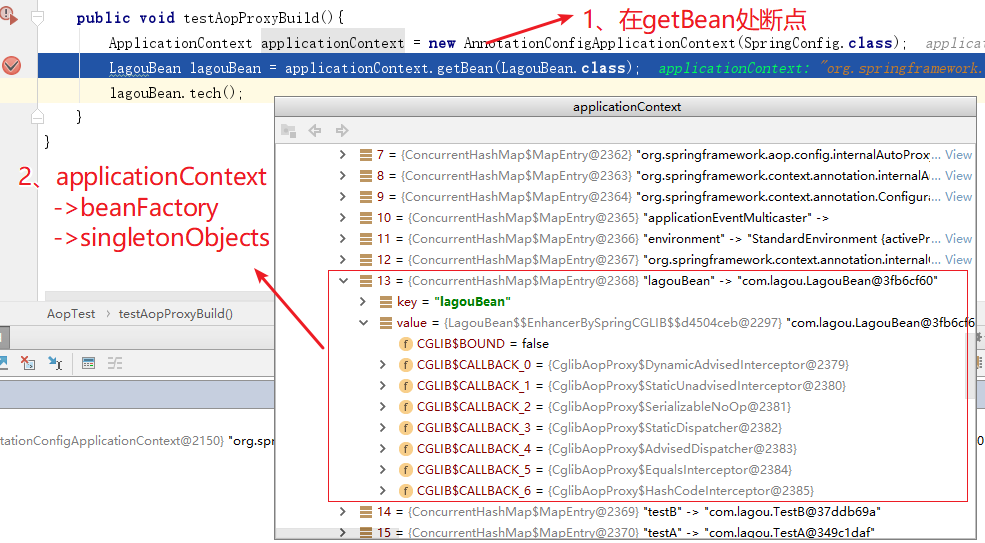
我们发现在 getBean 之前,LagouBean对象已经产生(即在第一行初始化代码中完成),而且该对象
是一个代理对象(Cglib代理对象),我们断定,容器初始化过程中目标Ban已经完成了代理,返回了代
理对象。
# 1.3 代理对象创建流程
AbstractAutowireCapableBeanFactory#initializeBean(java.lang.String, java.lang.Object,
org.springframework.beans.factory.support.RootBeanDefinition)
/**
*
* 初始化Bean
包括Bean后置处理器初始化
Bean的一些初始化方法的执行init-method
Bean的实现的声明周期相关接口的属性注入
*/
protected Object initializeBean(final String beanName, final Object bean, @Nullable RootBeanDefinition mbd) {
// 执行所有的AwareMethods
if (System.getSecurityManager() != null) {
AccessController.doPrivileged((PrivilegedAction<Object>) () -> {
invokeAwareMethods(beanName, bean);
return null;
}, getAccessControlContext());
}
else {
invokeAwareMethods(beanName, bean);
}
Object wrappedBean = bean;
if (mbd == null || !mbd.isSynthetic()) {
// 执行所有的BeanPostProcessor#postProcessBeforeInitialization初始化之前的处理器方法
wrappedBean = applyBeanPostProcessorsBeforeInitialization(wrappedBean,beanName);
}
try {
// 这里就开始执行afterPropertiesSet(实现了InitializingBean接口)方法和initMethod
invokeInitMethods(beanName, wrappedBean, mbd);
}
catch (Throwable ex) {
throw new BeanCreationException((mbd != null ? mbd.getResourceDescription() : null), beanName, "Invocation of init method failed", ex);
}
if (mbd == null || !mbd.isSynthetic()) {
// 整个Bean初始化完成,执行后置处理器方法
wrappedBean = applyBeanPostProcessorsAfterInitialization(wrappedBean,beanName);
}
return wrappedBean;
}
2
3
4
5
6
7
8
9
10
11
12
13
14
15
16
17
18
19
20
21
22
23
24
25
26
27
28
29
30
31
32
33
34
35
36
37
AbstractAutowireCapableBeanFactory#applyBeanPostProcessorsAfterInitialization
@Override
public Object applyBeanPostProcessorsAfterInitialization(Object existingBean, String beanName) throws BeansException {
Object result = existingBean;
// 循环执行后置处理器
for (BeanPostProcessor processor : getBeanPostProcessors()) {
Object current = processor.postProcessAfterInitialization(result,
beanName);
if (current == null) {
return result;
}
result = current;
}
return result;
}
2
3
4
5
6
7
8
9
10
11
12
13
14

创建代理对象的后置处理器AbstractAutoProxyCreator#postProcessAfterInitialization
/**
* Create a proxy with the configured interceptors if the bean is
* identified as one to proxy by the subclass.
* @see #getAdvicesAndAdvisorsForBean
*/
@Override
public Object postProcessAfterInitialization(@Nullable Object bean, String beanName) {
if (bean != null) {
// 检查下该类是否已经暴露过了(可能已经创建了,比如A依赖B时,创建A时候,就会先去创建B。
// 当真正需要创建B时,就没必要再代理一次已经代理过的对象),避免重复创建
Object cacheKey = getCacheKey(bean.getClass(), beanName);
if (this.earlyProxyReferences.remove(cacheKey) != bean) {
return wrapIfNecessary(bean, beanName, cacheKey);
}
}
return bean;
}
2
3
4
5
6
7
8
9
10
11
12
13
14
15
16
17
AbstractAutoProxyCreator#wrapIfNecessary
/**
* Wrap the given bean if necessary, i.e. if it is eligible for being
proxied.
* @param bean the raw bean instance
* @param beanName the name of the bean
* @param cacheKey the cache key for metadata access
* @return a proxy wrapping the bean, or the raw bean instance as-is
*/
protected Object wrapIfNecessary(Object bean, String beanName, Object
cacheKey) {
// targetSourcedBeans包含,说明前面创建过
if (StringUtils.hasLength(beanName) &&
this.targetSourcedBeans.contains(beanName)) {
return bean;
}
if (Boolean.FALSE.equals(this.advisedBeans.get(cacheKey))) {
eturn bean;
}
if (isInfrastructureClass(bean.getClass()) || shouldSkip(bean.getClass(),
beanName)) {
this.advisedBeans.put(cacheKey, Boolean.FALSE);
return bean;
}
// Create proxy if we have advice.
// 得到所有候选Advisor,对Advisors和bean的方法双层遍历匹配,最终得到一个
List<Advisor>,即specificInterceptors
Object[] specificInterceptors =
getAdvicesAndAdvisorsForBean(bean.getClass(), beanName, null);
if (specificInterceptors != DO_NOT_PROXY) {
this.advisedBeans.put(cacheKey, Boolean.TRUE);
// 重点,创建代理对象
Object proxy = createProxy(
bean.getClass(), beanName, specificInterceptors, new
SingletonTargetSource(bean));
this.proxyTypes.put(cacheKey, proxy.getClass());
return proxy;
}
this.advisedBeans.put(cacheKey, Boolean.FALSE);
return bean;
}
2
3
4
5
6
7
8
9
10
11
12
13
14
15
16
17
18
19
20
21
22
23
24
25
26
27
28
29
30
31
32
33
34
35
36
37
38
39
40
41
AbstractAutoProxyCreator#createProxy
/**
* Create an AOP proxy for the given bean.
* 为指定 bean 创建代理对象
*/
protected Object createProxy(Class<?> beanClass, @Nullable String beanName,@Nullable Object[] specificInterceptors, TargetSource targetSource) {
if (this.beanFactory instanceof ConfigurableListableBeanFactory) {
AutoProxyUtils.exposeTargetClass((ConfigurableListableBeanFactory) this.beanFactory, beanName, beanClass);
}
// 创建代理的工作交给ProxyFactory
ProxyFactory proxyFactory = new ProxyFactory();
proxyFactory.copyFrom(this);
// 根据一些情况判断是否要设置proxyTargetClass=true
if (!proxyFactory.isProxyTargetClass()) {
if (shouldProxyTargetClass(beanClass, beanName)) {
proxyFactory.setProxyTargetClass(true);
}
else {
evaluateProxyInterfaces(beanClass, proxyFactory);
}
}
// 把指定和通用拦截对象合并, 并都适配成Advisor
Advisor[] advisors = buildAdvisors(beanName, specificInterceptors);
proxyFactory.addAdvisors(advisors);
// 设置参数
proxyFactory.setTargetSource(targetSource);
customizeProxyFactory(proxyFactory);
proxyFactory.setFrozen(this.freezeProxy);
if (advisorsPreFiltered()) {
proxyFactory.setPreFiltered(true);
}
// 上面准备做完就开始创建代理
return proxyFactory.getProxy(getProxyClassLoader());
}
2
3
4
5
6
7
8
9
10
11
12
13
14
15
16
17
18
19
20
21
22
23
24
25
26
27
28
29
30
31
32
33
接着跟进到ProxyFactory中
public class ProxyFactory extends ProxyCreatorSupport {
public Object getProxy(ClassLoader classLoader) {
// 用ProxyFactory创建AopProxy, 然后用AopProxy创建Proxy, 所以这里重要的是看获取的AopProxy
// 对象是什么,
// 然后进去看怎么创建动态代理, 提供了两种:jdk proxy, cglib
return createAopProxy().getProxy(classLoader);
}
}
2
3
4
5
6
7
8
public class ProxyCreatorSupport extends AdvisedSupport {
private AopProxyFactory aopProxyFactory;
public ProxyCreatorSupport() {
this.aopProxyFactory = new DefaultAopProxyFactory();
}
protected final synchronized AopProxy createAopProxy() {
if (!this.active) {
activate();
}
//先获取创建AopProxy的工厂, 再由此创建AopProxy
return getAopProxyFactory().createAopProxy(this);
}
public AopProxyFactory getAopProxyFactory() {
return this.aopProxyFactory;
}
}
2
3
4
5
6
7
8
9
10
11
12
13
14
15
16
17
18
流程就是用AopProxyFactory创建AopProxy, 再用AopProxy创建代理对象,这里的AopProxyFactory默认是DefaultAopProxyFactory,看他的createAopProxy方法
public class DefaultAopProxyFactory implements AopProxyFactory, Serializable {
@Override
public AopProxy createAopProxy(AdvisedSupport config) throws AopConfigException {
if (config.isOptimize() || config.isProxyTargetClass() ||
hasNoUserSuppliedProxyInterfaces(config)) {
Class<?> targetClass = config.getTargetClass();
if (targetClass == null) {
throw new AopConfigException("TargetSource cannot determine target class: " + "Either an interface or a target is required for proxy creation.");
}
if (targetClass.isInterface()) {
return new JdkDynamicAopProxy(config);
}
return new ObjenesisCglibAopProxy(config);
} else {
return new JdkDynamicAopProxy(config);
}
}
/**
* Determine whether the supplied {@link AdvisedSupport} has only the
* {@link org.springframework.aop.SpringProxy} interface specified (or no
* proxy interfaces specified at all).
*/
private boolean hasNoUserSuppliedProxyInterfaces(AdvisedSupport config) {
Class<?>[] interfaces = config.getProxiedInterfaces();
return (interfaces.length == 0 || (interfaces.length == 1 &&
SpringProxy.class.equals(interfaces[0])));
}
}
2
3
4
5
6
7
8
9
10
11
12
13
14
15
16
17
18
19
20
21
22
23
24
25
26
27
28
29
这里决定创建代理对象是用JDK Proxy,还是用 Cglib 了,最简单的从使用方面使用来说:设置
proxyTargetClass=true强制使用Cglib 代理,什么参数都不设并且对象类实现了接口则默认用JDK 代理,如果没有实现接口则也必须用Cglib
ProxyFactory#getProxy(java.lang.ClassLoader)
------ CglibAopProxy#getProxy(java.lang.ClassLoader)
@Override
public Object getProxy(@Nullable ClassLoader classLoader) {
if (logger.isTraceEnabled()) {
logger.trace("Creating CGLIB proxy: " + this.advised.getTargetSource());
}
try {
Class<?> rootClass = this.advised.getTargetClass();
Assert.state(rootClass != null, "Target class must be available for creating a CGLIB proxy");
Class<?> proxySuperClass = rootClass;
if (ClassUtils.isCglibProxyClass(rootClass)) {
proxySuperClass = rootClass.getSuperclass();
Class<?>[] additionalInterfaces = rootClass.getInterfaces();
for (Class<?> additionalInterface : additionalInterfaces) {
this.advised.addInterface(additionalInterface);
}
}
// Validate the class, writing log messages as necessary.
validateClassIfNecessary(proxySuperClass, classLoader);
// 配置 Cglib 增强
Enhancer enhancer = createEnhancer();
if (classLoader != null) {
enhancer.setClassLoader(classLoader);
if (classLoader instanceof SmartClassLoader &&((SmartClassLoader) classLoader).isClassReloadable(proxySuperClass)) {
enhancer.setUseCache(false);
}
}
enhancer.setSuperclass(proxySuperClass);
enhancer.setInterfaces(AopProxyUtils.completeProxiedInterfaces(this.advised));
enhancer.setNamingPolicy(SpringNamingPolicy.INSTANCE);
enhancer.setStrategy(new
ClassLoaderAwareUndeclaredThrowableStrategy(classLoader));
Callback[] callbacks = getCallbacks(rootClass);
Class<?>[] types = new Class<?>[callbacks.length];
for (int x = 0; x < types.length; x++) {
types[x] = callbacks[x].getClass();
}
// fixedInterceptorMap only populated at this point, after getCallbacks call above
enhancer.setCallbackFilter(new ProxyCallbackFilter(
this.advised.getConfigurationOnlyCopy(), this.fixedInterceptorMap,
this.fixedInterceptorOffset));
enhancer.setCallbackTypes(types);
// 生成代理类,并且创建一个代理类的实例
return createProxyClassAndInstance(enhancer, callbacks);
}
catch (CodeGenerationException | IllegalArgumentException ex) {
throw new AopConfigException("Could not generate CGLIB subclass of " + this.advised.getTargetClass() + ": Common causes of this problem include using a final class or a non-visible class", ex);
}
catch (Throwable ex) {
// TargetSource.getTarget() failed
throw new AopConfigException("Unexpected AOP exception", ex);
}
}
2
3
4
5
6
7
8
9
10
11
12
13
14
15
16
17
18
19
20
21
22
23
24
25
26
27
28
29
30
31
32
33
34
35
36
37
38
39
40
41
42
43
44
45
46
47
48
49
50
51
52
AOP源码分析类方法调用关系课堂讲解过程中记录
org.springframework.beans.factory.support.AbstractAutowireCapableBeanFactory#initializeBean
调用
org.springframework.beans.factory.support.AbstractAutowireCapableBeanFactory#applyBeanPostProcessorsAfterInitialization
调用
org.springframework.aop.framework.autoproxy.AbstractAutoProxyCreator#postProcessAfterInitialization(后置处理器AbstractAutoProxyCreator完成bean代理对象创建)
调用
org.springframework.aop.framework.autoproxy.AbstractAutoProxyCreator#wrapIfNecessary
调用
org.springframework.aop.framework.autoproxy.AbstractAutoProxyCreator#createProxy (在这一步把委托对象的aop增强和通用拦截进行合并,最终给代理对象)
调用
org.springframework.aop.framework.DefaultAopProxyFactory#createAopProxy
调用
org.springframework.aop.framework.CglibAopProxy#getProxy(java.lang.ClassLoader)
2
3
4
5
6
7
8
9
10
11
12
13
14
15
16
17
18
19
20
21
22
23
24
25
26
27
28
29
30
31
32
33
34
35
36
37
# 第2节 Spring声明式事务控制
声明式事务很方便,尤其纯注解模式,仅仅几个注解就能控制事务了
思考:这些注解都做了什么?好神奇!
@EnableTransactionManagement @Transactional
# 2.1 @EnableTransactionManagement
@Target(ElementType.TYPE)
@Retention(RetentionPolicy.RUNTIME)
@Documented
@Import(TransactionManagementConfigurationSelector.class)
public @interface EnableTransactionManagement {
2
3
4
5
@EnableTransactionManagement 注解使用 @Import 标签引入了
TransactionManagementConfigurationSelector类,这个类又向容器中导入了两个重要的组件

# 2.2 加载事务控制组件
- AutoProxyRegistrar
AutoProxyRegistrar 类的 registerBeanDefinitions 方法中又注册了一个组件
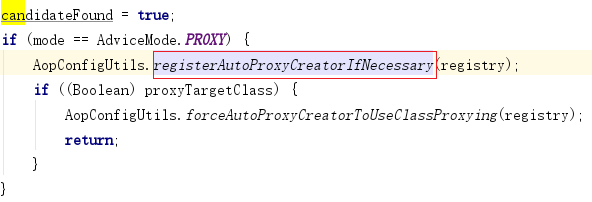
进入 AopConfigUtils.registerAutoProxyCreatorIfNecessary 方法

发现最终,注册了一个叫做 InfrastructureAdvisorAutoProxyCreator 的 Bean,而这个类是
AbstractAutoProxyCreator 的子类,实现了 SmartInstantiationAwareBeanPostProcessor 接口
public class InfrastructureAdvisorAutoProxyCreator extends AbstractAdvisorAutoProxyCreator
public abstract class AbstractAdvisorAutoProxyCreator extends AbstractAutoProxyCreator
public abstract class AbstractAutoProxyCreator extends ProxyProcessorSupport implements SmartInstantiationAwareBeanPostProcessor, BeanFactoryAware
2
3
4
5
6
7
继承体系结构图如下
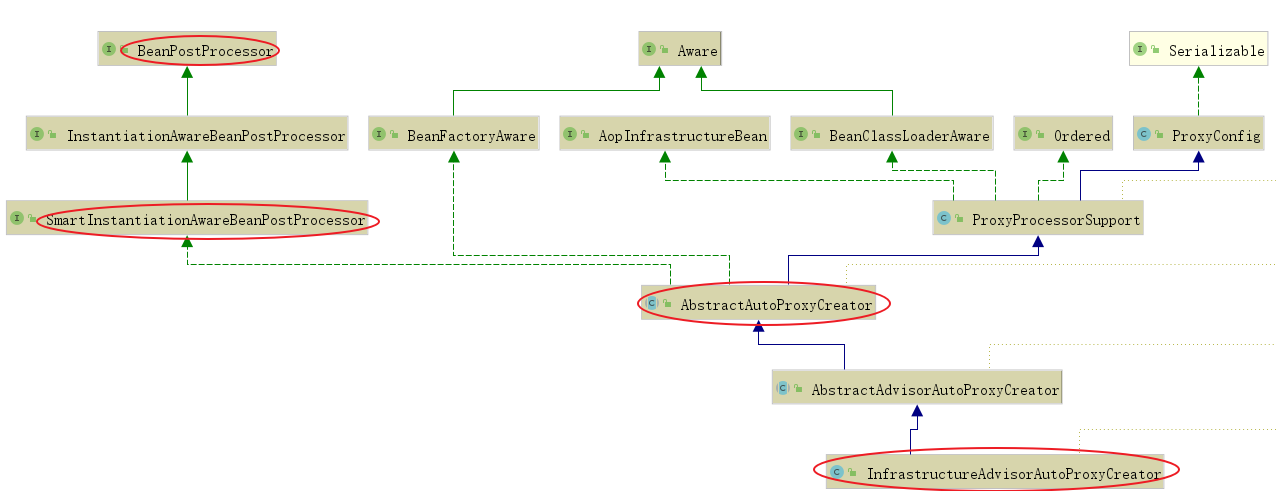
它实现了SmartInstantiationAwareBeanPostProcessor,说明这是一个后置处理器,而且跟
spring AOP 开启@EnableAspectJAutoProxy 时注册的 AnnotationAwareAspectJProxyCreator实
现的是同一个接口,所以说,声明式事务是 springAOP 思想的一种应用
- ProxyTransactionManagementConfiguration 组件
/*
* Copyright 2002-2017 the original author or authors.
*
* Licensed under the Apache License, Version 2.0 (the "License");
* you may not use this file except in compliance with the License.
* You may obtain a copy of the License at
*
*
https://www.apache.org/licenses/LICENSE-2.0
*
* Unless required by applicable law or agreed to in writing, software
* distributed under the License is distributed on an "AS IS" BASIS,
* WITHOUT WARRANTIES OR CONDITIONS OF ANY KIND, either express or
implied.
* See the License for the specific language governing permissions and
* limitations under the License.
*/
package org.springframework.transaction.annotation;
import org.springframework.beans.factory.config.BeanDefinition;
import org.springframework.context.annotation.Bean;
import org.springframework.context.annotation.Configuration;
import org.springframework.context.annotation.Role;
import org.springframework.transaction.config.TransactionManagementConfigUtils;
import org.springframework.transaction.interceptor.BeanFactoryTransactionAttribut
eSourceAdvisor;
import org.springframework.transaction.interceptor.TransactionAttributeSource;
import org.springframework.transaction.interceptor.TransactionInterceptor;
/**
* {@code @Configuration} class that registers the Spring infrastructure
beans
* necessary to enable proxy-based annotation-driven transaction
management.
*
* @author Chris Beams
* @since 3.1
* @see EnableTransactionManagement
* @see TransactionManagementConfigurationSelector
*/
@Configuration
public class ProxyTransactionManagementConfiguration extends AbstractTransactionManagementConfiguration {
@Bean(name = TransactionManagementConfigUtils.TRANSACTION_ADVISOR_BEAN_NAME)
@Role(BeanDefinition.ROLE_INFRASTRUCTURE)
public BeanFactoryTransactionAttributeSourceAdvisor transactionAdvisor()
{
// 事务增强器
BeanFactoryTransactionAttributeSourceAdvisor advisor = new
BeanFactoryTransactionAttributeSourceAdvisor();
// 向事务增强器中注入 属性解析器 transactionAttributeSource
advisor.setTransactionAttributeSource(transactionAttributeSource());
// 向事务增强器中注入 事务拦截器 transactionInterceptor
advisor.setAdvice(transactionInterceptor());
if (this.enableTx != null) {
advisor.setOrder(this.enableTx.<Integer>getNumber("order"));
}
return advisor;
}
@Bean
@Role(BeanDefinition.ROLE_INFRASTRUCTURE)
// 属性解析器 transactionAttributeSource
public TransactionAttributeSource transactionAttributeSource() {
return new AnnotationTransactionAttributeSource();
}
@Bean
@Role(BeanDefinition.ROLE_INFRASTRUCTURE)
// 事务拦截器 transactionInterceptor
public TransactionInterceptor transactionInterceptor() {
TransactionInterceptor interceptor = new TransactionInterceptor();
interceptor.setTransactionAttributeSource(transactionAttributeSource());
if (this.txManager != null) {
interceptor.setTransactionManager(this.txManager);
}
return interceptor;
}
}
2
3
4
5
6
7
8
9
10
11
12
13
14
15
16
17
18
19
20
21
22
23
24
25
26
27
28
29
30
31
32
33
34
35
36
37
38
39
40
41
42
43
44
45
46
47
48
49
50
51
52
53
54
55
56
57
58
59
60
61
62
63
64
65
66
67
68
69
70
71
72
73
74
75
76
77
78
ProxyTransactionManagementConfiguration是一个容器配置类,注册了一个组件
transactionAdvisor,称为事务增强器,然后在这个事务增强器中又注入了两个属性:
transactionAttributeSource,即属性解析器transactionAttributeSource 和 事务拦截器
transactionInterceptor
- 属性解析器 AnnotationTransactionAttributeSource 部分源码如下
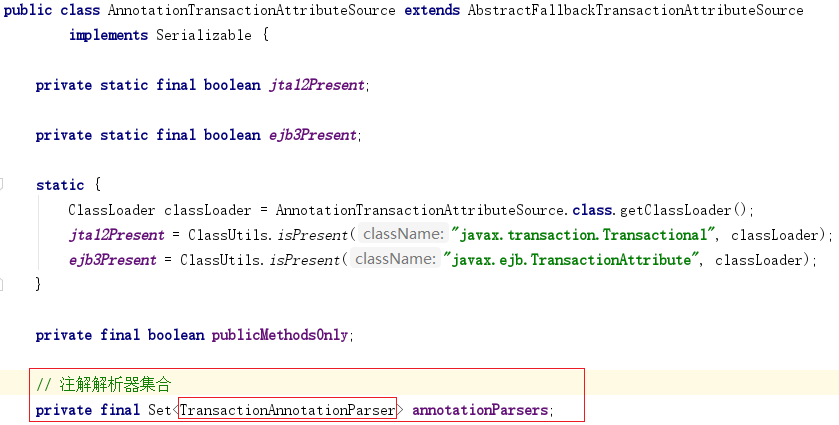
属性解析器有一个成员变量是annotationParsers,是一个集合,可以添加多种注解解析器
(TransactionAnnotationParser),我们关注 Spring 的注解解析器,部分源码如下
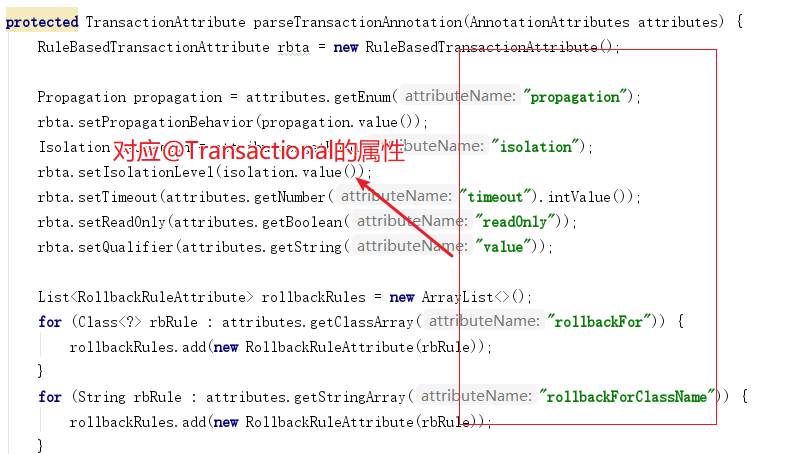
属性解析器的作用之一就是用来解析@Transaction注解
- TransactionInterceptor 事务拦截器,部分源码如下


上述组件如何关联起来的?
- 事务拦截器实现了MethodInterceptor接口,追溯一下上面提到的InfrastructureAdvisorAutoProxyCreator后置处理器,它会在代理对象执行目标方法的时候获取其拦截器链,而拦截器链就是这个TransactionInterceptor,这就把这两个组件联系起来;
- 构造方法传入PlatformTransactionManager(事务管理器)、TransactionAttributeSource(属性解析器),但是追溯一下上面贴的ProxyTransactionManagementConfiguration的源码,在注册事务拦截器的时候并没有调用这个带参构造方法,而是调用的无参构造方法,然后再调用set方法注入这两个属性,效果一样。
invokeWithinTransaction 方法,部分源码如下(关注1、2、3、4 标注处)

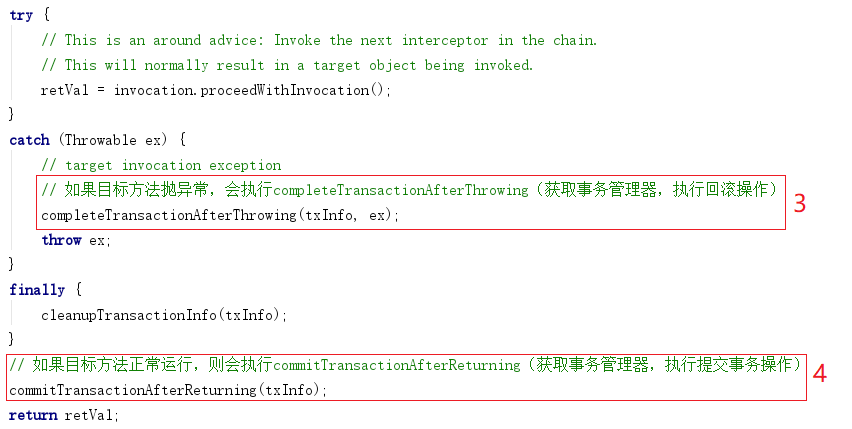
声明式事务分析课堂讲解过程中记录
@EnableTransactionManagement 注解
1)通过@import引入TransactionManagementConfigurationSelector类
它的selectImports方法导入了另外两个类:AutoProxyRegistrar和ProxyTransactionManagementConfiguration
2)AutoProxyRegistrar类分析
方法registerBeanDefinitions中,引入了其他类,通过AopConfigUtils.registerAutoProxyCreatorIfNecessary(registry)引入InfrastructureAdvisorAutoProxyCreator,它继承了AbstractAutoProxyCreator,是一个后置处理器类
3)ProxyTransactionManagementConfiguration 是一个添加了@Configuration注解的配置类
(注册bean)
注册事务增强器(注入属性解析器、事务拦截器)
属性解析器:AnnotationTransactionAttributeSource,内部持有了一个解析器集合
Set<TransactionAnnotationParser> annotationParsers;
具体使用的是SpringTransactionAnnotationParser解析器,用来解析
@Transactional的事务属性
事务拦截器:TransactionInterceptor实现了MethodInterceptor接口,该通用拦截
会在产生代理对象之前和aop增强合并,最终一起影响到代理对象
TransactionInterceptor的invoke方法中invokeWithinTransaction会触发原有业
务逻辑调用(增强事务)
2
3
4
5
6
7
8
9
10
11
12
13
14
15
16
17
18
19
20

